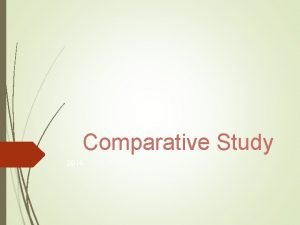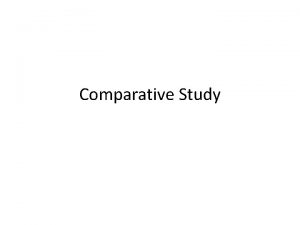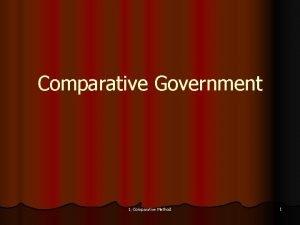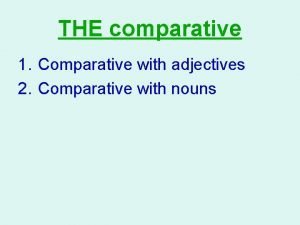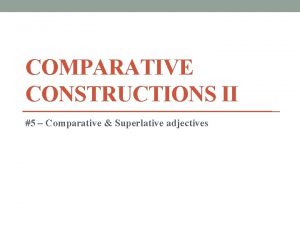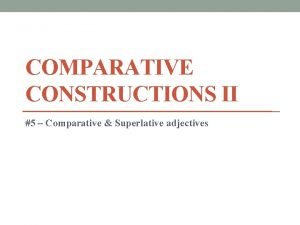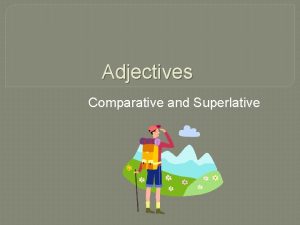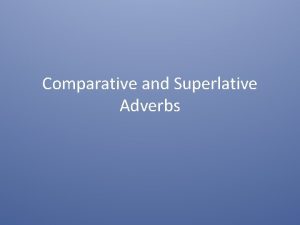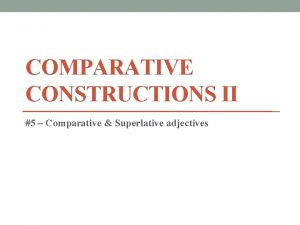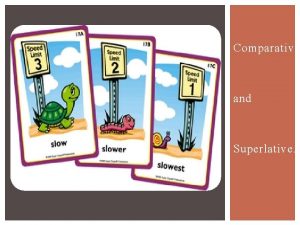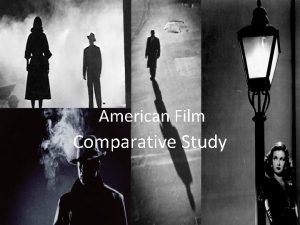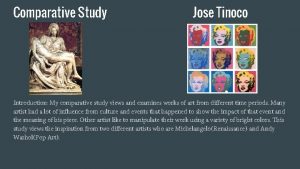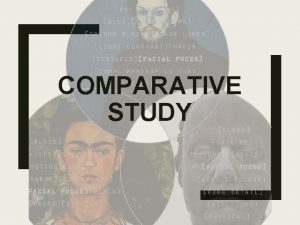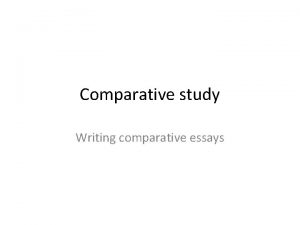COMPARATIVE STUDY What is the comparative study An

















- Slides: 17

COMPARATIVE STUDY



What is the comparative study? ■ An in depth analysis and comparison between three different artworks by at least two artists from different cultural contexts ■ An opportunity to demonstrate your understanding for the artist works that have inspired and driven your art making practice

Formal requirements ■ Comparative study is worth 20% ■ SL students submit 10 -15 screens ■ HL students submit and additional 3 -5 screens which analyse the extent to which the artists discussed have influenced their studio work

Remember! ■ In text referencing as well as a list of sources at the end ■ When importing images resize them to a maximum height or width of 1, 500 pixels ■ Use a consistent design scheme for your presentation. Keep it subtle and easy to read ■ Make it aesthetically appealing! Communicate with visuals and graphics where possible

Marking criteria Marks A Analysis of formal qualities 6 B Interpretation of function and purpose 6 C Evaluation of cultural significance 6 D Making comparisons and connections 6 E Presentation and subject specific language 6 F (HL only) Making connections to own art making practice 12 (HL only) /30 SL /42 HL

Research ■ The IB strongly recommends that at least one of the works explored in the comparative study is a work that you have experienced first hand ■ Ensure web research is also backed up with books, journals, articles, documentaries etc. ■ Where possible try contacting the artist!

Intro Title- Comparative Study Your name Brief introduction- who you’re studying, which pieces and what the main theme is that you’re looking at. For each artist include■ Artist’s name ■ Name of Artwork ■ Image of artwork ■ Date created

Apply Mc. Fee King’s conceptual framework Audience’s world Audience (response) Artwork Artist’s world

What to analyse… ■ What media, processes and techniques have been used in each of the artworks? ■ What aspects of the processes and techniques are conventional or innovative? ■ How have formal qualities, such as the elements and principles of design, been used and to what effect (or affect)? ■ What motifs, signs and symbols have been used in the works and what do these communicate to the audience? ■ How have the artists’ methodologies influenced the student’s own art-making? (HL only) Use your writing frameworks in your assessment bookle


Explain the significance ■ What are the social, historical, political and intellectual contexts of each of the works explored? ■ How do the artworks reflect aspects of the world in which they were created? ■ What experiences of the world does the audience bring to their interpretation and appreciation of the artworks? ■ How has exploring these contexts influenced the students’ own artmaking? (HL only)

Compare and contrast. . ■ Venn diagram ■ Similarities ■ Differences

Significance to own work ■ Across the three pages. . . ■ Significance of theme to their work and your own work ■ Links / similarities of artists work to your own.

Timeframe- HL Anyone falling behind with this schedule will sacrifice their double practical lesson and be referred to DG. It is VERY achievable!! Date Task 10/10 Intro (Pg 1) 17/10 Artist 1 - Analysis (Pg 2), Mc. Fee (Pg 3), Significcance (Pg 4) 24/10 Artist 2 - Analysis (Pg 5), Mc. Fee (Pg 6), Significcance (Pg 7) 31/10 Artist 3 - Analysis (Pg 8), Mc. Fee (Pg 9), Significcance (Pg 10) 07/11 Comparison Venn (Pg 11) , Similarities (Pg 12) and Differences (Pg 13) 14/11 Refine / Make Changes. 21/11 Significance of Artworks to your own work (Pgs 14, 15 and 16) 28/11 Significance of Artworks to your own work (Pgs 14, 15 and 16) 05/12 Refine / Make Changes. Bibliography (Pg 17) 12/12 Bibliography (Pg 17) HAND IN- 14 / 12 / 16

Timeframe- SL Anyone falling behind with this schedule will sacrifice their double practical lesson and be referred to DG. It is VERY achievable!! Date Task 10/10 Intro (Pg 1) 17/10 Artist 1 - Analysis (Pg 2), Mc. Fee (Pg 3), Significcance (Pg 4) 24/10 31/10 Artist 2 - Analysis (Pg 5), Mc. Fee (Pg 6), Significcance (Pg 7) 07/11 14/11 Artist 3 - Analysis (Pg 8), Mc. Fee (Pg 9), Significcance (Pg 10) 21/11 28/11 Comparison Venn (Pg 11) , Similarities (Pg 12) and Differences (Pg 13) 05/12 12/12 Bibliography (Pg 16) HAND IN- 14 / 12 / 16
 Các châu lục và đại dương trên thế giới
Các châu lục và đại dương trên thế giới độ dài liên kết
độ dài liên kết ưu thế lai là gì
ưu thế lai là gì Các môn thể thao bắt đầu bằng tiếng bóng
Các môn thể thao bắt đầu bằng tiếng bóng Thẻ vin
Thẻ vin Hình ảnh bộ gõ cơ thể búng tay
Hình ảnh bộ gõ cơ thể búng tay Cái miệng xinh xinh thế chỉ nói điều hay thôi
Cái miệng xinh xinh thế chỉ nói điều hay thôi Từ ngữ thể hiện lòng nhân hậu
Từ ngữ thể hiện lòng nhân hậu Trời xanh đây là của chúng ta thể thơ
Trời xanh đây là của chúng ta thể thơ Tư thế ngồi viết
Tư thế ngồi viết Thế nào là giọng cùng tên? *
Thế nào là giọng cùng tên? * Chó sói
Chó sói Thể thơ truyền thống
Thể thơ truyền thống Sự nuôi và dạy con của hổ
Sự nuôi và dạy con của hổ Thế nào là hệ số cao nhất
Thế nào là hệ số cao nhất Diễn thế sinh thái là
Diễn thế sinh thái là đại từ thay thế
đại từ thay thế Slidetodoc
Slidetodoc


















